The resistance band tricep extension is a convenient and, might I add, a highly effective exercise for training your triceps just about anywhere.
Performing tricep extensions with resistance bands taxes your triceps with constant, joint-friendly tension, which naturally leads to a more potent muscle pump than you’d get with free weight equivalents.
This detailed guide shows you how to do 9 different types of resistance band tricep extensions so that you can blast your tris from every angle and stimulate new muscle growth.
Related: Triceps workout with resistance bands
Resistance band tricep extension exercise details
- Also Known As: Tricep band extension
- Main Muscles: Triceps
- Exercise Type: Strength
- Exercise Mechanics: Isolation
- Difficulty Level: Intermediate
- Equipment Needed: Resistance bands
How to do tricep extensions with resistance bands

- Stand in the middle of your resistance band and then grab the handles with an overhand grip. Alternatively, use a door anchor to secure your band in a low position.
- Press the bands over your head so that your arms are locked out.
- Tuck your elbows in, and then lower the band handles behind your head by bending your elbows.
- Descend until you feel an intense stretch in the backs of your arms.
- Reverse the movement by flexing your triceps forcefully until your elbows reach complete extension.
- Repeat for 3-5 sets of 12-30 reps.
Resistance band tricep extension variations
The resistance band overhead tricep extension that you just saw above is an excellent mass-builder because it optimally trains the largest head of the triceps—the long head—via an intense eccentric stretch and a powerful peak contraction.
Yet, you can make your workout routine even more effective by performing other resistance band triceps extensions to increase your training volume and time under tension.
Free-weight banded tricep extension
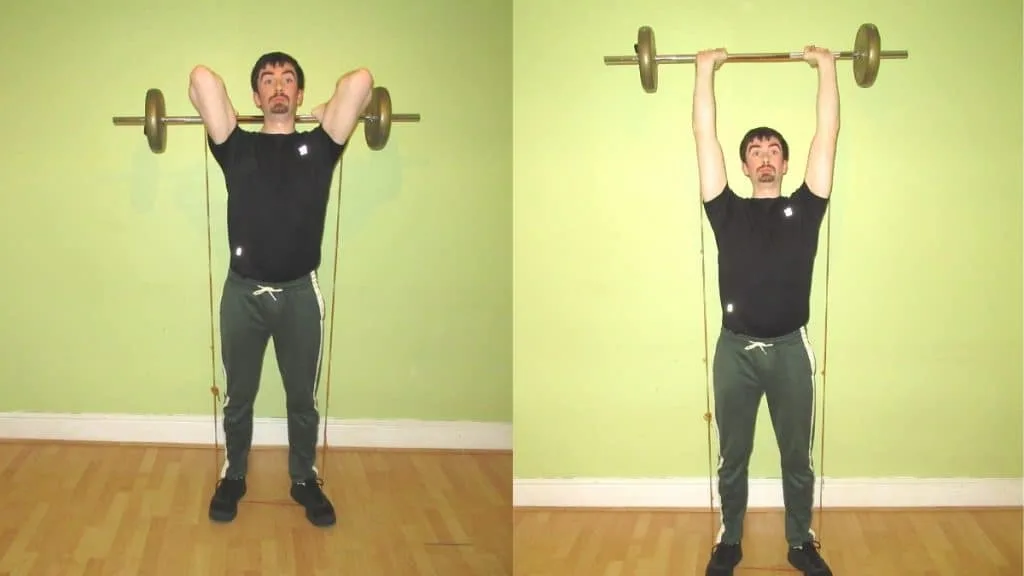
Free-weight tricep extensions are a proven exercise for building impressive triceps.
But they have one major flaw that the resistance band version doesn’t; free-weight extensions don’t provide constant tension.
When you lock your elbows out at the top of the rep, the vast majority of the tension is going through your joints instead of your triceps muscles.
The same is true (albeit to a lesser extent) when you’re in the stretched position at the bottom of the rep—your triceps are effectively just resting because your forearms (and thereby the weight) are themselves resting on your biceps.
The solution is to combine bands and free weights to create the most optimal tricep extension.
Free weight extensions provide a better eccentric stretch, but banded triceps extensions offer constant tension a more potent peak contraction. So why not enjoy the benefits of both exercises?
You can! And you can do so simultaneously.
Simply hold a resistance band in your hands and then grab your weights. You’ll need to lift lighter than usual because now you have the band tension to contend with, which increases the closer your elbows get to lockout.
Then, you just perform an overhead tricep extension as usual, as described in the initial tutorial.
You’ll notice that your triceps have to work much harder to lock out the weight and that you can’t just rest at the top of the rep because the band is always exerting some kind of force on your triceps.
One arm resistance band overhead tricep extension
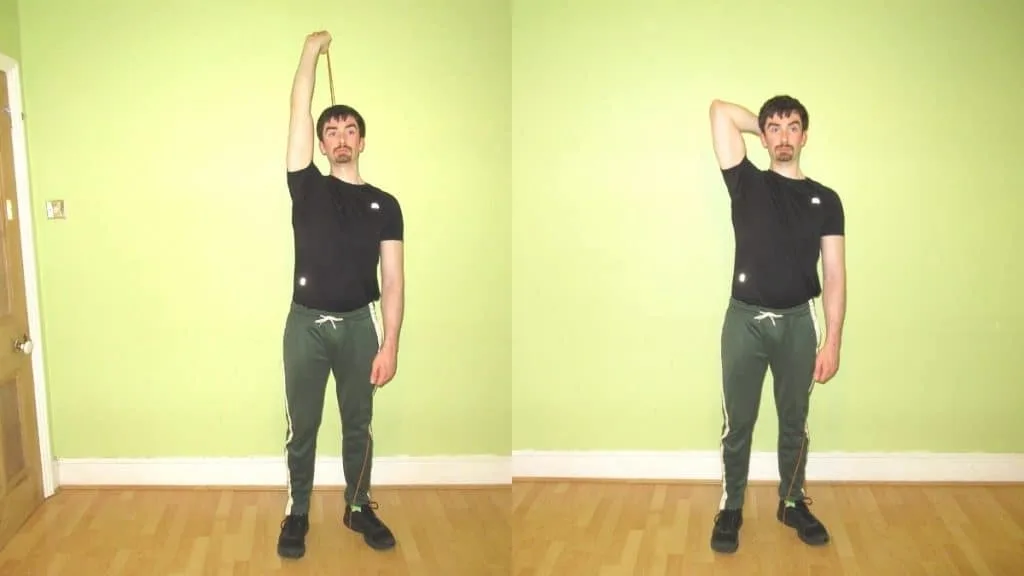
If you want to sculpt maximum triceps symmetry to build proportional upper arms, then the one arm resistance band tricep extension is the best exercise for the job.
Training each arm separately means that you don’t have to split your focus across two limbs. This enhanced focus, in turn, helps you to establish a stronger mind-muscle connection with your triceps and achieve a better pump as a result.
The only downside (if you can call it that) is that your sets will take longer when you train in a unilateral fashion. It’s the same story with the one arm dumbbell tricep extension.
Of course, this extra workout time may well be worth the symmetry gains for many people. This is especially true if you already have a solid foundation of triceps size, in which case you’ll actually have enough muscle mass to make the symmetry improvements visible.
Alternating resistance band tricep extension

There’s one standout advantage to the alternating resistance band triceps extension: It enables you to perform more reps during every set.
When you perform banded tricep extensions in an alternating fashion, your triceps get a short rest period in which the lactic acid has a chance to dissipate. This means that your triceps will be less fatigued than usual during their subsequent repetitions.
As such, you’ll be able to perform a higher number of reps per set and accumulate more total training volume, which is the primary driver of muscle hypertrophy.
Of course, performing a few extra reps during each set isn’t exactly going to transform your triceps.
Nevertheless, you’re still getting extra training volume for free, which no serious lifter can complain about.
Reverse grip resistance band tricep extensions
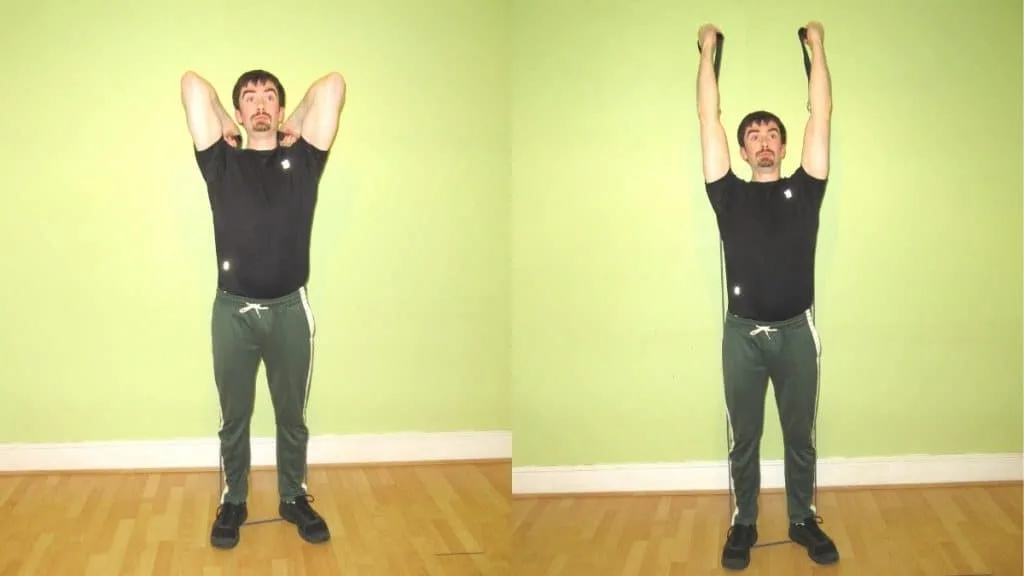
Resistance band reverse grip tricep extensions are a great exercise because the supinated hand position encourages you to keep your elbows tucked in, which in turn can take some of the pressure off your joints.
However, since the triceps are pure elbow extensors (with the exception of the long head, which also acts on the shoulder), they aren’t affected by your hand, wrist, or forearm positions in any way.
So using a reverse grip for banded tricep extensions is only useful insofar as it encourages external rotation of the shoulder joint. External rotation of the glenohumeral joint, in turn, helps you (it doesn’t force you) to keep your elbows tucked in. This often minimizes the pressure being put on your joints, which is why some lifters prefer the reverse grip resistance band tricep extension to the standard version.
You can, of course, mimic this elbow positioning with the regular resistance band overhead triceps extension by using strict form. If anything, the normal version is actually better for muscle growth because it enables you to push into the band handles with your hands and generate a lot more power during the concentric phase of the rep as a result.
See our overhead reverse grip triceps extension guide for more information and to learn how to do the exercise with different equipment.
Standing resistance band tricep extensions
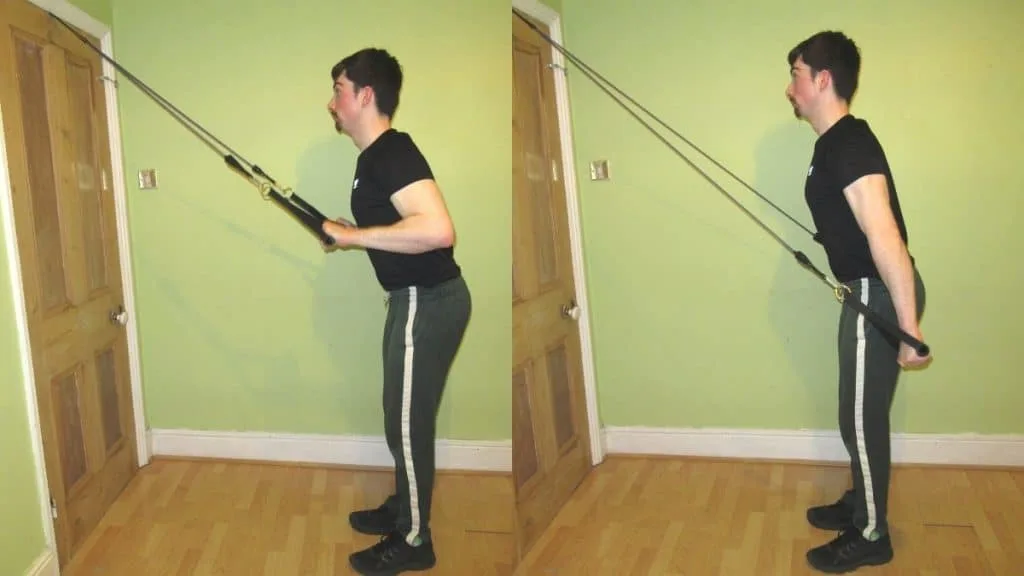
The standing resistance band tricep extension is basically a pushdown and, like the banded overhead extension, can be performed with both arms for maximum convenience or one arm at a time for extra triceps isolation.
When you’re doing a standing triceps extension with a band, make sure to extend the band slightly behind your torso so that you can generate a stronger peak contraction in the long head of your triceps.
If you perform the band extension like this, then the movement is basically the opposite of an overhead extension; rather than stretching the long head during the eccentric part of the rep, you’re now shortening it via an intensified peak contraction during the concentric phase.
So by combining the standing banded tricep extension with the banded overhead extension, you’ll be hitting the long head (which makes up around two-thirds of your triceps size) from the two most important angles, which is to say, while your shoulders are in extension and flexion.
Leaning resistance band triceps extension
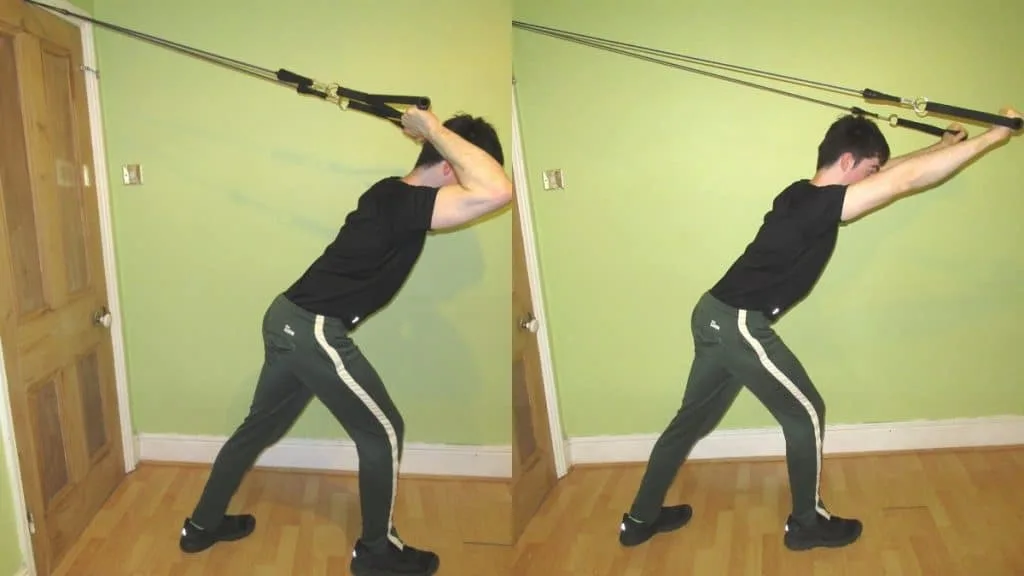
Leaning resistance band tricep extensions are best performed by connecting your band to a door anchor in a high position.
This setup enables you to achieve an intense eccentric triceps stretch and an extensive range of motion so that you can break down plenty of muscle fibers and stimulate hypertrophy.
You’ll also feel your core working because the bands will always be trying to pull your body back to the anchor point. So even though this is an isolation exercise, your abs will get a good isometric workout as well.
Like the other resistance band triceps extensions, you can perform the learning version with both arms together or in a unilateral fashion.
Side banded tricep extensions
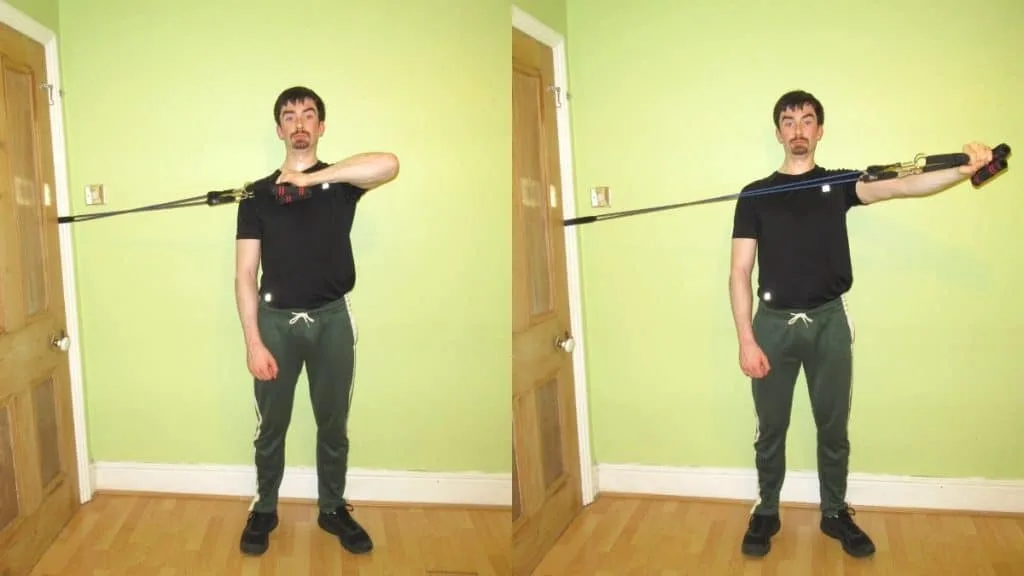
Side band tricep extensions are a unique and highly challenging exercise because you need to lift both band handles with the same arm, which effectively doubles the resistance (and to think that some bodybuilders say bands don’t build muscle!).
You can, of course, decrease the difficulty by using a single band that doesn’t have any handles (or by simply using a lighter band with handles if you have a set).
The idea is to raise your arm out to the side so that, in relation to your torso, your upper arm shoulder are both in roughly the same position that they would be during a bench press. So in this sense, the side extension has excellent carryover to your compound presses because you’re essentially doing heavy lockouts with your triceps.
Just make sure to keep your upper arm as still as possible once it’s in position so that you can keep the tension on your triceps. Only your forearm should move back and forth.
Lying tricep extension with a band
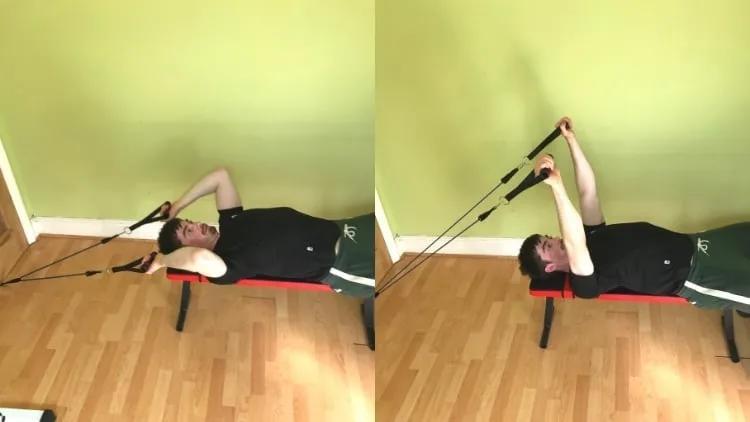
Performing lying triceps extensions with bands really taxes the long head of the triceps by putting your shoulders into flexion.
The exercise is commonly called the banded skull crusher, and you can certainly bring the band down to your face. However, to intensify the all-important eccentric stretch as much as possible, your best bet is to bring the bands behind your head.
You can perform this exercise by first connecting the band to an external anchor point and then lying on the bench. Or, you can actually hook the band under the top part of the bench, grab each end of the band while you’re laid down, and then start performing tricep extensions.
The first option is likely better for hypertrophy because the bands are already stretched when you begin the rep, which means that your triceps receive more time under tension. The downside is that you’ll need to use a lot of core strength to get the bands into position, which could sap your energy. That is, of course, unless you have someone to pass the bands to you.
Performing a resistance band lying tricep extension by hooking your band under the bench makes the setup more manageable if you don’t have a training partner. The drawback is that you don’t get much tension during the first part of the rep (unless you double loop the band) because the band isn’t stretched and therefore doesn’t contain any “energy” or tension that it can exert on your triceps.
Cross body resistance band tricep extension
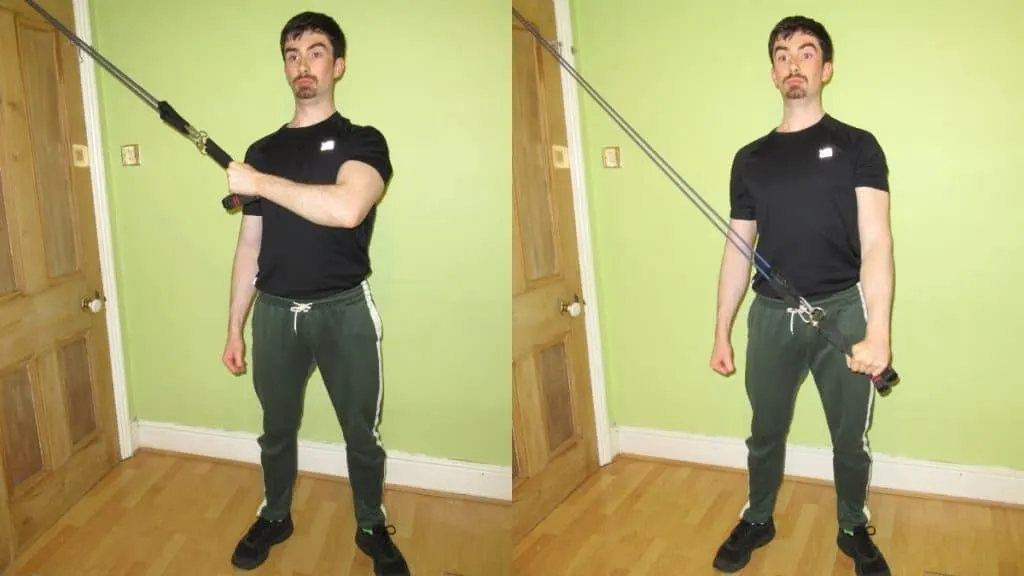
Performing the resistance band cross body tricep extension is an excellent way to encourage your triceps to grow in proportion because the exercise forces you to train each arm separately. This unilateral training style ensures that both sets of your arm muscles are getting equal amounts of work.
You’ll need access to a door anchor to do the cross body resistance band tricep extension properly. This is because you need to anchor the bar to the very top of your door so that the band can stretch enough to provide challenging tension levels for your triceps.
The trade-off of the tremendous triceps isolation is that your sets will take longer when you do banded tricep extensions in a cross body fashion. But is the resulting improvement in triceps symmetry worth the extra time and effort?
If you’re a beginner, then probably not. After all, novice lifters don’t usually have enough triceps size to make any kind of symmetry improvements noticeable.
Conversely, if you’ve already got good arm development and want your physique to look more aesthetic and proportional, then it could be well worth your time to do the band triceps extension in a unilateral/cross body fashion.
Seated resistance band tricep extension
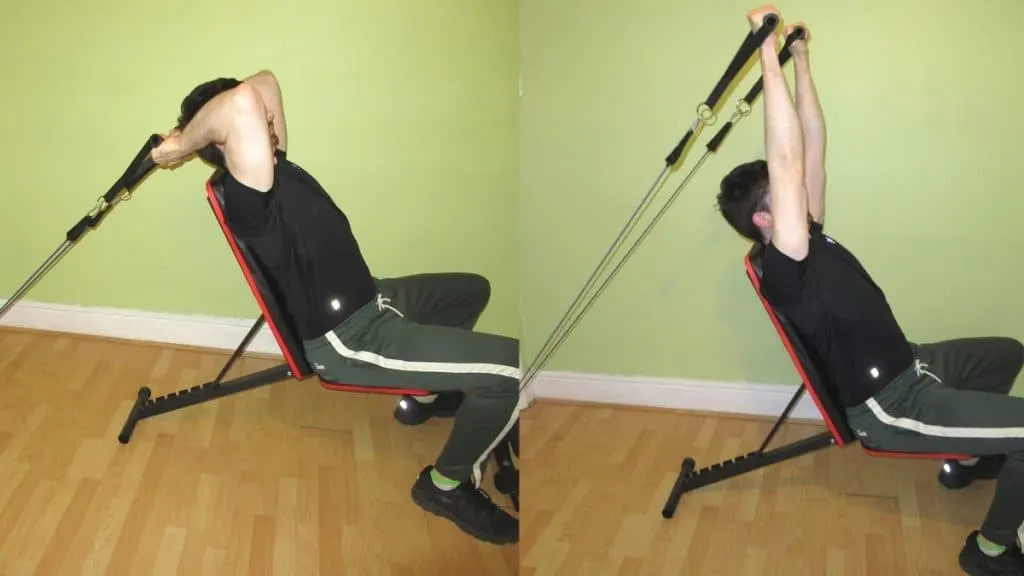
Like the seated dumbbell tricep extension, the seated resistance band tricep extension reduces the core stability requirement of the exercise because the backrest of the bench effectively stabilizes your torso for you.
This done-for-you stabilization enables you to maximize the purpose of a band tricep extension, which is to say triceps isolation.
The trade-off is that the sitting resistance band tricep extension burns fewer calories than doing a standing two-arm triceps extension with a band because your core and leg muscles aren’t as active when you’re sat down.
Therefore, if you’re cutting or just generally trying to lose fat, then you’re probably better off sticking to the standing band tricep extension in order to maximize your calorie burn.
Unless you’re lifting really heavy, which is unlikely with bands, you won’t to see much of a detriment to your triceps activation if you do the band extension in a standing position (even if the seated version does provide better triceps isolation in theory).
Kneeling resistance band tricep extension
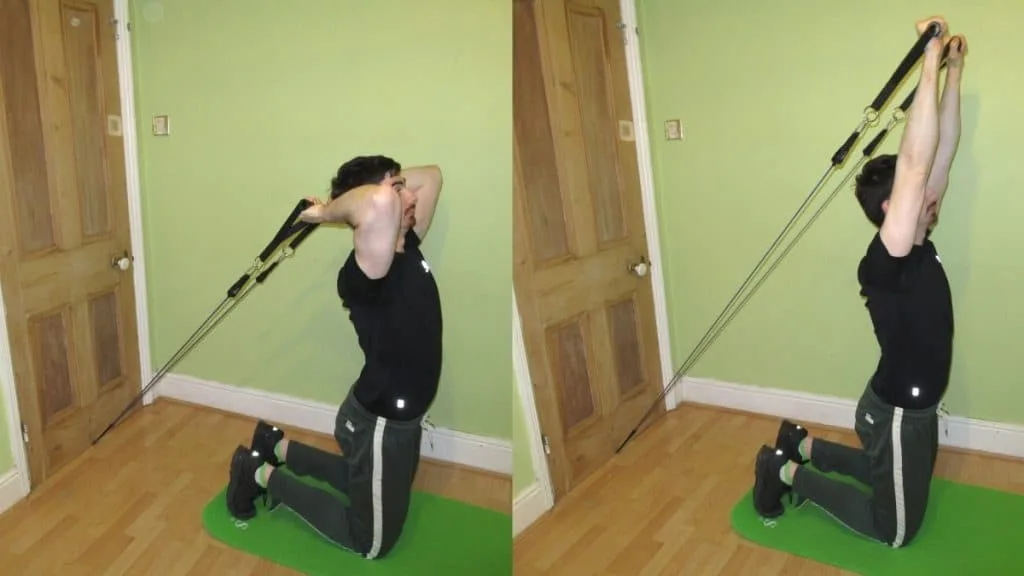
If you’ve got access to an exercise mat and want to work your abs and triceps simultaneously, then the kneeling resistance band tricep extension is a brilliant move to include in your routine.
Like the dumbbell kneeling tricep extension, the kneeling band tricep extension challenges your isometric ab strength while taxing your triceps with a deep, fiber-tearing eccentric stretch. This means that the movement, even though it’s a band exercise, has excellent carryover to free weight drills because it works your core a lot.
Again, you’ll need access to a door anchor (these come with most band sets) to make the most of the kneeling banded tricep extension.
Since the bands aren’t as stretched when you’re kneeling down, the kneeling resistance band tricep extension doesn’t feel as heavy as the standing version because the band doesn’t exert as much tension when it doesn’t have to travel as far.
Decline band tricep extensions
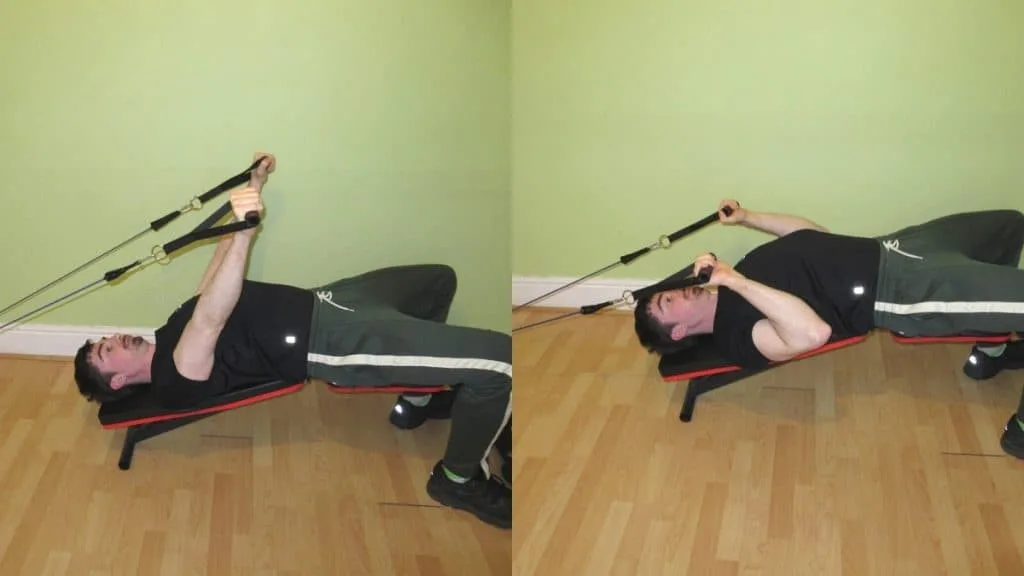
If you want to make the lying banded tricep extension even more challenging, then you can do the exercise on a decline bench.
Decline tricep extensions put the long head of the triceps under a greater stretch because they encourage your shoulders to move backward into flexion, which is the position in which the long head is most stretched and thus at its strongest.
The only drawback of the decline resistance band triceps extension is that it’s harder to set up. This is because you either have to lie back in order to pick up the bands (which could cause you to slide down the bench), or you have to grab the bands standing up and then walk them out to the bench, which is a very ab-intensive activity.
Incline tricep extensions with resistance bands
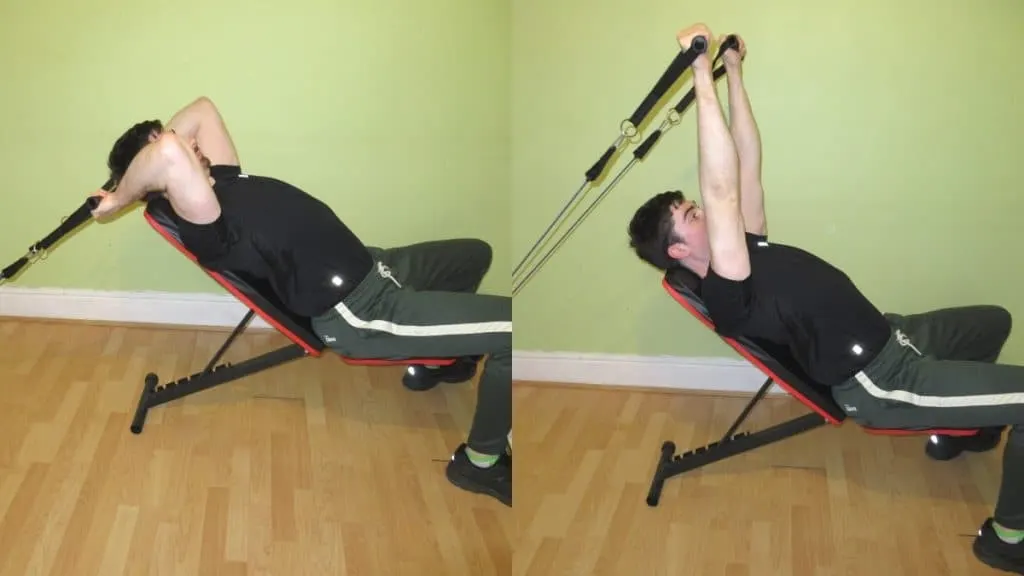
The incline resistance band tricep extension puts your tris under a tremendous eccentric muscle stretch that really primes them for growth.
Due to the highly flexed overhead shoulder position, the exercise isn’t ideal for those with rotator cuff issues (these people would be better off with the lying band tricep extension).
Nevertheless, for those with good shoulder mobility, the resistance band incline tricep extension is convenient and will definitely produce results with enough effort and consistency on your part. As will incline dumbbell overhead extensions.
While you can do the exercise from a high pulley, a low pulley setup is most recommended because it places your triceps under a more substantial stretch while putting less pressure on your elbows in the process (doing it from a high pulley turns it into a skull crusher-like exercise).
Band tricep extension benefits
Performing tricep extensions with resistance bands is a great way to work the backs of your arms without trekking to a gym. With a simple band set and a door anchor, you can achieve a gym-quality workout from the comfort of your own home.
Intense triceps pump
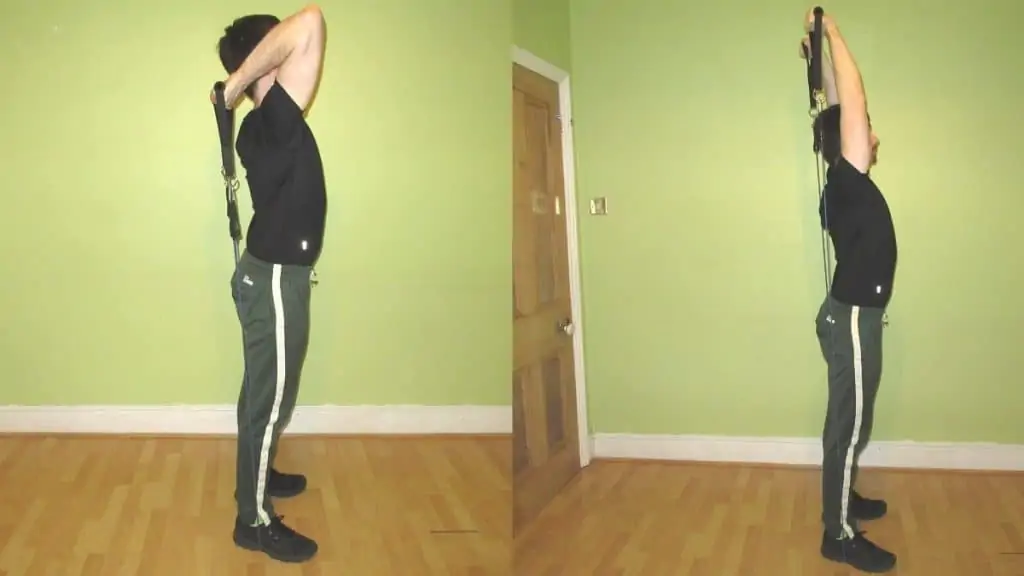
Unlike free weights, resistance bands challenge your muscle with constant tension. This leads to a more potent pump because, now that your triceps can’t rest during your reps, the lactic acid doesn’t have a chance to escape until the set is over.
Getting a killer tricep pump courtesy of resistance band tricep extensions will make your arms look visibly bigger and more vascular (even if only temporarily), a sight that can be very motivating to behold during training.
One thing that bands don’t provide, however, is consistent resistance. While your triceps certainly get put under tension at every point in the rep, the resistance varies according to how much the band is stretched.
This is why resistance band overhead extensions are the top choice; they allow the band to become more stretched than other banded tricep extension variations and thus exert more tension on your triceps.
Remarkable convenience
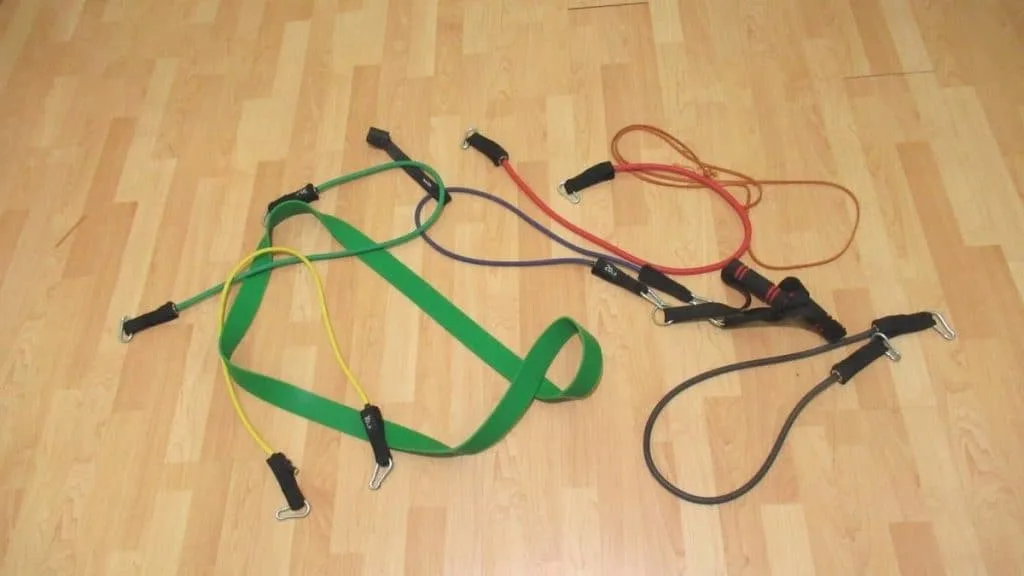
You can do tricep band extensions regardless of whether you’re at home, at the beach, in the park, or in the gym.
All you need is a band and a spare 5-10 minutes.
This means that you don’t need to skip workouts if you can’t get to the gym, which will help you to achieve more consistent results in muscle size and strength.
In fact, in the same time that it would take you to get to the gym, you could have already trained your triceps with banded extensions and countless other exercises. So in terms of time efficiency, resistance bands are just about the best tricep training tool in existence.
Since bands typically provide very joint-friendly resistance, this exercise is also ideal if you often get elbow pain during tricep extensions when lifting free weights.
Builds upper arm mass
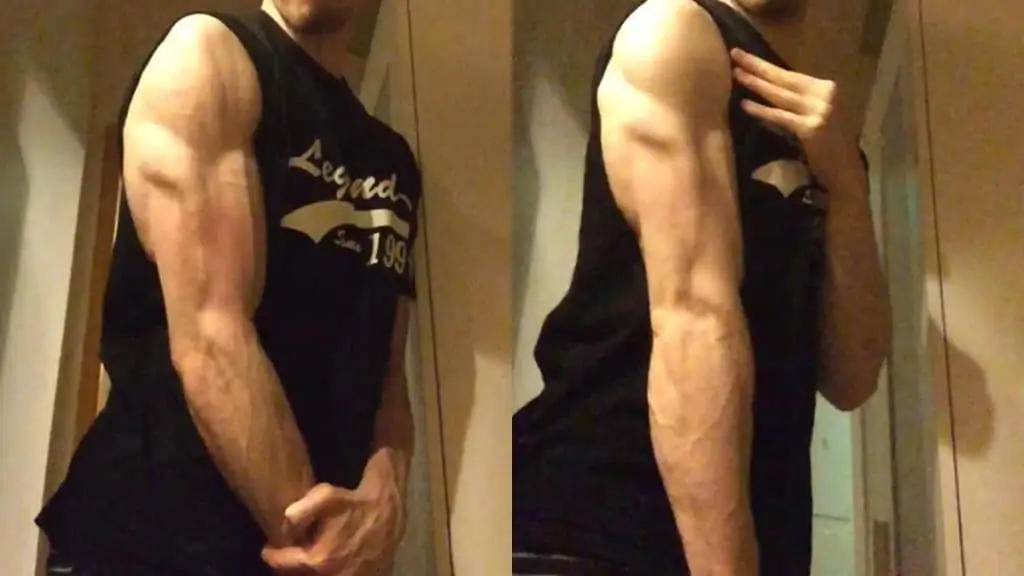
As mentioned, the long head of the triceps accounts for around two-thirds of your total triceps mass, which means that it’s bigger than the lateral and medial heads combined.
Therefore, if you want to build your arms, then there are no two ways about it; you have to focus on the long head.
Any kind of band tricep extension that has your shoulders in either flexion (arms behind your head) or in extension (arms behind your body) emphasizes the long head.
So, in this respect, you’re literally spoilt for choice because practically every type of band triceps extension has a big long head focus and thereby a lot of mass-building potential.
Conclusion: Which type of banded tricep extension is the most effective?
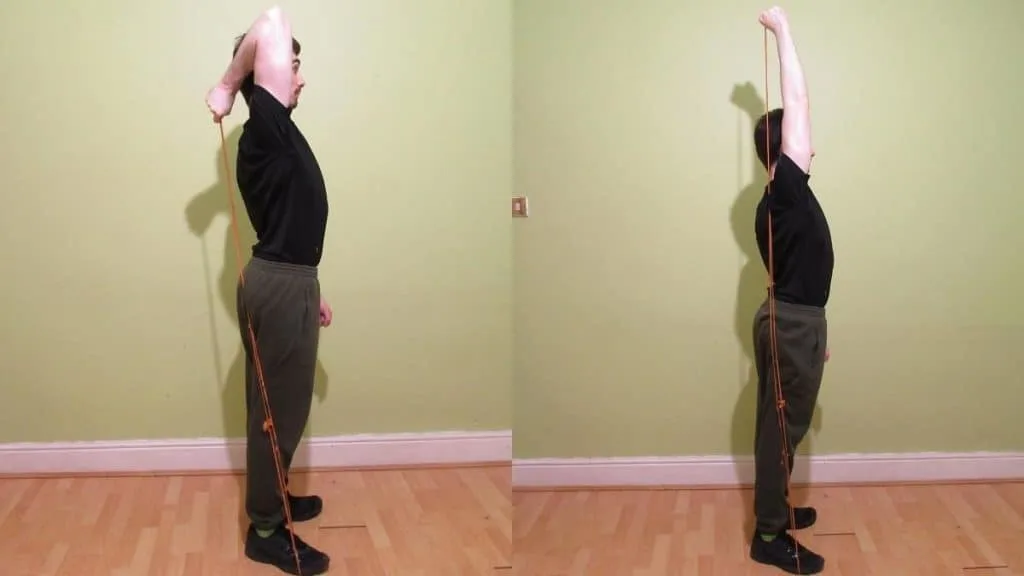
For maximum convenience, the resistance band overhead extension is the best option because you don’t need a door anchor; you can literally perform the exercise anywhere.
For sculpting symmetrical triceps, the one arm resistance band overhead tricep extension is an excellent choice because you can really hone in on both of your triceps to ensure that they receive equal amounts of work.
The side extension is ideal for working the lateral head of your triceps because, since your shoulders are neither in maximum flexion nor maximum extension, the long head won’t contribute as much force toward the movement. This means that the lateral and medial heads have to do more of the lifting, which means that they also receive a greater share of the tension.

